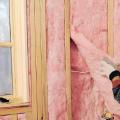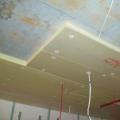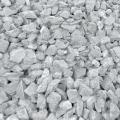Building materials - technical characteristics
Decorativeness is characterized by special aesthetic properties of building facing materials of various origins, “such as color, shine, pattern, texture, etc. These properties are preserved for a long time during operation.
To add shine, various methods are used depending on the type of material: for dense rocks (granite, marble, labradorite, etc.) polishing is used to a mirror surface; glaze is applied to ceramic materials, enamel is applied to glass, etc. These methods also help to increase the water resistance and durability of materials.
Texture refers to the nature of the front surface of the material, its appearance. The texture of various parts is selected depending on their purpose. For artificial building materials (cladding ceramics, glass, decorative concrete, etc.), the texture can be smooth, corrugated, embossed, patterned, etc.
Acoustic properties. There are such acoustic properties as sound absorption, sound insulation, sound permeability.
Sound absorption is the ability of a material to absorb sound waves incident on it; is estimated by the sound absorption coefficient.
Sound-absorbing materials are characterized by high porosity with a predominance of connected and branched pores and are designed to reduce noise in rooms.
Sound insulation is the ability of a material to resist the passage of a sound wave. This ability is characterized by the degree to which sound pressure levels are reduced as a result of sound passing through a structure.
Sound permeability is the ability of a material to transmit sound waves.
Electrical conductivity characterizes the ability of a material to conduct electric current and is measured by specific electrical conductivity in Siemens per meter (S/m). Electrically conductive materials are metals, as well as some materials in a wet state (wood, concrete). The ability of metal to pass electric current is used to tension reinforcement. Most building materials have electrical insulating properties (dense mineral materials: porcelain, glass, marble, etc.).
Transparency is the ability of a material to transmit light rays, which provides see-through visibility. Transparent materials include window sheet glass, the light transmittance of which is 84 ... 87%, some polymer materials: plexiglass, transparent fiberglass, films.
Gas permeability. If there is a difference in gas pressure (air) at the outer and inner surfaces of the wall of a structure, or the pressure is the same, but the temperatures of the gases are different, then they move through the pores and cracks of the material, that is, the phenomenon of gas permeability is observed.
Gas permeability is estimated by the gas permeability coefficient kg, kg / (m s Pa), which is determined by the mass of gas passing through 1 MPa of the surface area of a layer of material 1 m thick per unit of time (1 s), when the gas pressure difference is 1 MPa. The gas permeability of a material depends primarily on the number and nature of pores and humidity.
Radiation impermeability is the ability of a building material to be protected from radioactive influences. Good absorbers of neutrons and radiation are materials containing a significant amount of chemically bound water, and super-heavy materials (hydrate concrete, limonite, magnetite, barite), as well as lead. Such materials are used in the construction of nuclear power plants and other nuclear power facilities.
Weather resistance is the ability of a material to resist destruction under the influence of atmospheric factors: heating (day) and cooling (at night), wetting and drying; exposure to dust, gases contained in the atmosphere, etc.
The weatherproof brush is an integral element of weather resistance. In porcelain brush we usually understand the ability of a material to withstand repeated hygroscopic wetting and drying, during which no deformation, loss of strength is observed, and the load-bearing capacity of the material is not reduced.
Biostability is the ability of a material to resist destruction under the influence of biological processes that may occur during the operation of structures. The cause of biological processes is the vital activity of moss, lichens (destruction of concrete, some natural stone materials), fungal organisms (rotting wood), etc.
Corrosion resistance is a generalized concept of a material’s resistance to destruction or deterioration in quality from the combined action of various factors and processes (atmospheric factors, chemical and electrochemical processes, biological destruction, pollution, etc.).
Aging is characterized by a change in the structure and quality of building materials (metals, bitumen, polymer materials, etc.) over time under the influence of various factors during operation. Aging, as a rule, is accompanied by the appearance of cracks, increased fragility, pottyanin-yum, fading and other phenomena that reduce the quality of the material.
Reliability is a generalized characteristic of a material consisting of the following interrelated properties, such as durability, reliability, maintainability and safety.
Durability is the ability of a material to serve for a long time in specific climatic and production conditions under the established operating conditions without loss of performance. Durability characterizes the property of a material (product), with the necessary breaks for repairs, to maintain its working ability to a limit state, which is characterized by the degree of destruction of the product, safety requirements and economic feasibility. Durability is assessed by the permissible service life. For example, regulatory documents for reinforced concrete products establish three degrees of durability: 1 - no less than 100 years, 2 - no less than 50 years, 3 - no less than 20 years. 
Reliability is characterized by the property of a material or product, under certain modes and operating conditions, to remain operational for a certain time without forced breaks for repairs.
Maintainability is the ability of a product to accept repairs and adjustments, as a result of which its technical characteristics (product quality) are restored and preserved. Indicators of maintainability are the average time, labor intensity and cost of repairs.
Safety is the ability of a material not to lose quality indicators during and after the storage and transportation period established by the technical documentation. Estimated by the period of storage to failure.
Hygiene characterizes the ability of a material to withstand repeated cleaning and washing of the work surface without reducing its qualities. Hygienic materials include materials with a dense, waterproof, durable, resistant to detergents and removal of the working surface: glazed ceramic materials, enameled glass tiles, glass ceramics and the like.
Transportability is the ability of a material or product without special containers and packaging to endure downloading, transportation and unloading without violating its structural integrity, cracks, chips, etc.
Performance properties include properties that are generally characterized as chemical resistance, that is, the ability of materials not to be destroyed under the influence of cysts, alkalis, solutions of salts and gases.
 Construction materials and list of works
Construction materials and list of works Proper insulation of a wooden ceiling in a private house
Proper insulation of a wooden ceiling in a private house What types of crushed stone are there?
What types of crushed stone are there?